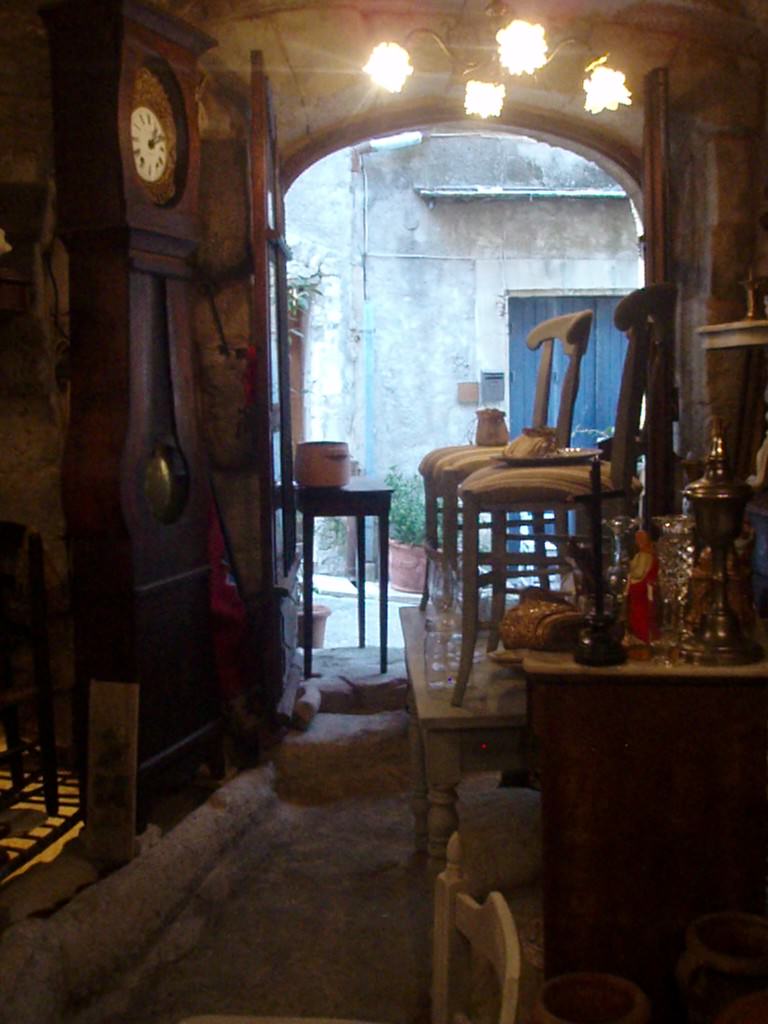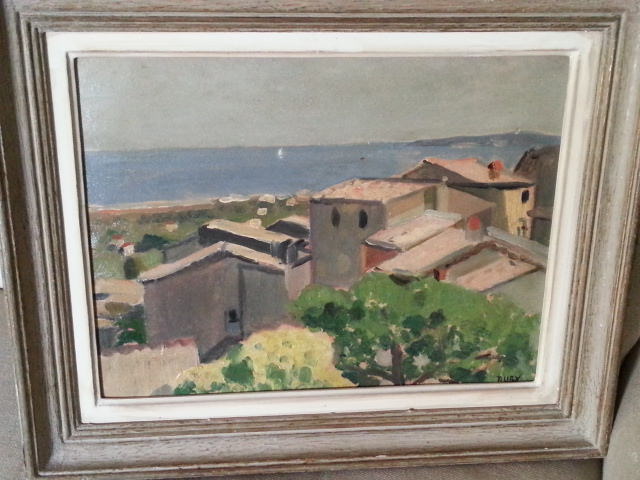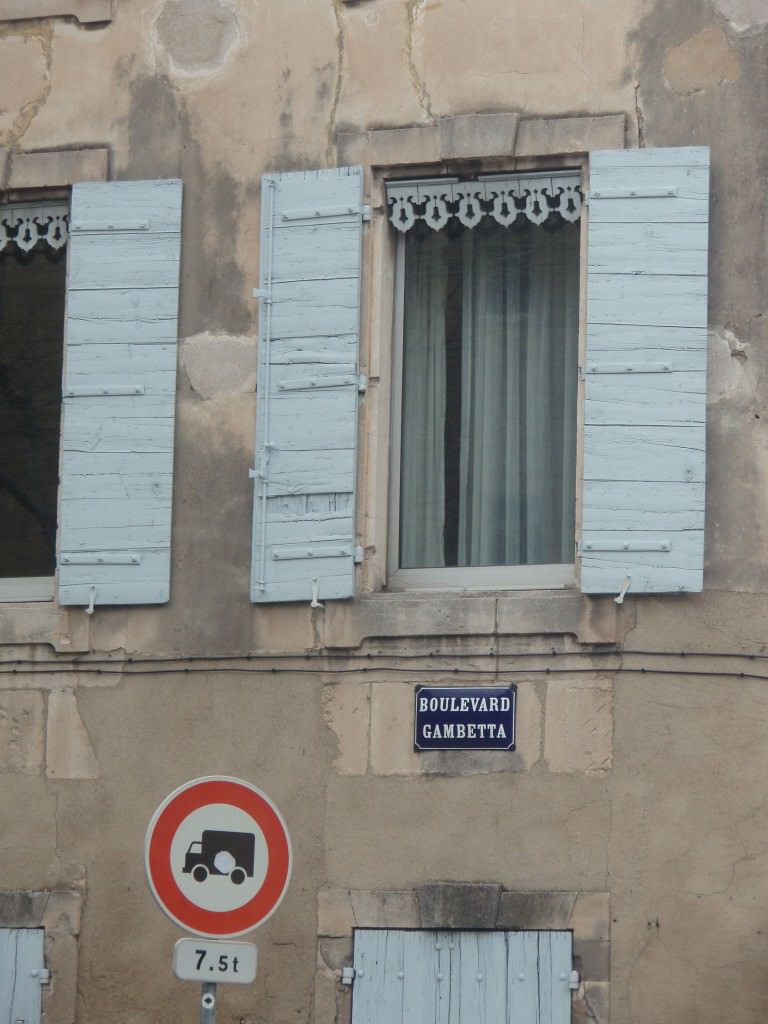
I stayed the night just outside Arles in a village I had known well when I was twenty. As I walked down the “Passage du Temps Retrouvé“, it was on my mind how in thirty or forty years a place can change entirely, a business grows then closes, someone moves away and is lost. Time can not be refound, but oh the delight of coming across someone who says “Ah yes, I remember….” (And so it is with antiques – here is a way of reaching back through time and touching the lives of those who lived before).
Supper in a rustic restaurant was garlicky. I ordered an excellent red wine from the Mas de la Dame, near Les Beaux. Van Gogh had painted the Mas, the farmhouse, and his picture was printed on the label. When I asked for a carafe of tap water the affable owner said, “Ah you mean, Chateau la Pompe du Village!” I walked back to my chambre d’hotes under a deep velvet star-studded sky thinking of Van Gogh and the time he spent in Provence, translating this vibrant landscape to canvas. Toads called out as loud as ducks, the perfume of wood smoke and fertile earth hung on the air.
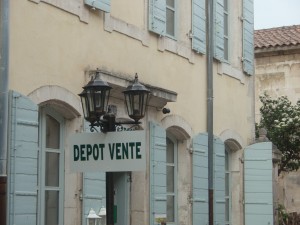 I stopped the following morning in St Remy de Provence, all plumped up and preened to receive its summer population. Plush estate agents were selling large properties with high walls and electric gates. Farrow & Ball, in all its retail splendour, had set up shop. There were still the old places with shutters painted bottle green, but Charcoal, Elephant and Dove Grey were de rigeur.
I stopped the following morning in St Remy de Provence, all plumped up and preened to receive its summer population. Plush estate agents were selling large properties with high walls and electric gates. Farrow & Ball, in all its retail splendour, had set up shop. There were still the old places with shutters painted bottle green, but Charcoal, Elephant and Dove Grey were de rigeur.
I continued past orchards of stubby fruit trees full of white blossom and ranks of bare, pruned vines, the tumbling rocky range of Les Alpilles in the distance to my left. Lush tall new grass and banks of dandelions grew along the road. I looked at the slivers of bright silvery light through the olive trees, the low ochre tiled farmhouses, the cypress trees, seeing them as a Van Gogh landscape.
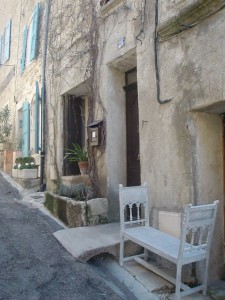 On towards the Luberon with its stunning villages perched on rocky slopes, I stopped in Bonnieux to visit Vincent, a dealer I’d met a few years before. I found his tiny shop down a steep street with pieces of furniture tucked into doorways and ledges outside. A cat dozed on the warm soil of a planter. There was no sign of Vincent but at the back of the shop I could see a log fire burning, and a faint smell of turpentine and spirit was on the air, so I waited.
On towards the Luberon with its stunning villages perched on rocky slopes, I stopped in Bonnieux to visit Vincent, a dealer I’d met a few years before. I found his tiny shop down a steep street with pieces of furniture tucked into doorways and ledges outside. A cat dozed on the warm soil of a planter. There was no sign of Vincent but at the back of the shop I could see a log fire burning, and a faint smell of turpentine and spirit was on the air, so I waited.
Vincent returned from a late lunch. “I have just reinstalled myself in here for the summer – everything has to come out over the winter, it is too damp, the house is cut into the hill.” Not only did he have the log fire burning to encourage an ambient humidity for his furniture, but also a large upright stove which shot out sparks into the gloom as he fed in more wood. The stone floor had gulleys and large holes carved into it. “It is from the sixth century,” said Vincent, “ it was an olive oil mill. But upstairs is of the 13th century – you would like to see my atelier?”
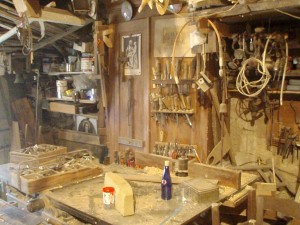 He led me up a narrow stone winding staircase and through his tiny, dark apartment, heavy beamed, sumptuous, laden with antique linen, chandeliers and decorative objets, up some more worn stone steps to his dusty, dark and very atmospheric atelier. The door at the back led out to a lane higher up the hill. “This was my father’s workshop too.” A 17th century carved saint propped up in the corner was waiting for restoration; a bureau all glued and clamped; clusters of rusting decorative metalwork and appliques, ready for use should the need ever arise; boxes of fittings; shelves with pots and unguents. “I never throw anything away,” he grinned. We talked enthusiatically about caseins and acrylics, lime and chalk. I lifted the lid off a large tub of fragrant turpentine and beeswax – a timeless smell. “Oh, and smell this”, said Vincent holding out a small blue glass bottle, “it is wonderful, non? I always mix fresh lavender oil in my wax.”
He led me up a narrow stone winding staircase and through his tiny, dark apartment, heavy beamed, sumptuous, laden with antique linen, chandeliers and decorative objets, up some more worn stone steps to his dusty, dark and very atmospheric atelier. The door at the back led out to a lane higher up the hill. “This was my father’s workshop too.” A 17th century carved saint propped up in the corner was waiting for restoration; a bureau all glued and clamped; clusters of rusting decorative metalwork and appliques, ready for use should the need ever arise; boxes of fittings; shelves with pots and unguents. “I never throw anything away,” he grinned. We talked enthusiatically about caseins and acrylics, lime and chalk. I lifted the lid off a large tub of fragrant turpentine and beeswax – a timeless smell. “Oh, and smell this”, said Vincent holding out a small blue glass bottle, “it is wonderful, non? I always mix fresh lavender oil in my wax.”
Back in his shop Vincent showed me photographs of the Creche that he builds each Christmas in the Vieille Eglise. It takes him nine days to construct a whole Provencal village populated with Santon dolls at their daily work.
Vincent wrapped up two small 18th century dull gold satin “aumoniers”, purses used by children after their communion to collect alms. Too exquisite not to buy. A large grape carrying hopper – which just about fitted in the car – and a “surtout de table”, a mirrored tray standing in an ornate gilt frame, also came with me. As we shook hands I told Vincent how much I appreciated his openness and warmth.
